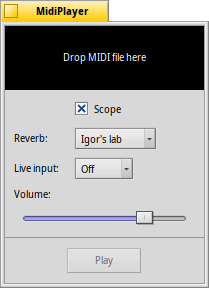 MidiPlayer
MidiPlayer
| Deskbar: | ||
| Location: | /boot/system/apps/MidiPlayer | |
| Settings: | ~/config/settings/MidiPlayerSettings |
As the name suggests, MidiPlayer is used to playback MIDI music files. MIDI files are special, as they don't contain the actual digitized and in some way encoded music, but only a description of it: Hold this note for that long with this volume and use instrument X for it.
While this keeps file sizes pretty small, it also follows that depending on the instrument library (the so-called "SoundFont") the results can differ hugely. Also, these SoundFonts tend to be quite large, increasingly so with the number and quality of the instrument samples.
Haiku releases include a small but relatively high quality SoundFont. People who use MIDI more seriously often already have very high quality or custom SoundFonts.
To use other SoundFonts (that don't come installable via HaikuDepot as a HPKG), just copy the .sf file to e.g. ~/config/non-packaged/data/synth/. You can select the active SoundFont in the Media preferences under .

MidiPlayer's interface is very simple. Just double-click or drag & drop a midi file and playback starts. You control the volume with the slider and add reverb effects from the pop-up menu. Activating the scope will show a visualization in form of an oscilloscope running at the top.